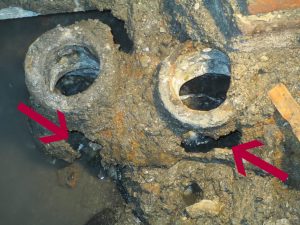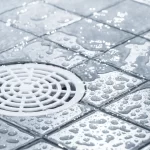Today we’re going to tell you all about running traps. Our Toronto plumbing and drain professionals have run into these devices in a number of properties throughout the City. They are outdated ticking time bombs that need to be replaced as soon as possible.
Building traps have been a hot topic in the plumbing community for years now, an artifact from another era that, while a good idea when they were first being used, have actually become dangerous in the modern day. In fact, building traps are such a problem that they have been outlawed entirely. This means if you have a building trap, you may need to look into building trap removal to protect your home and your family from the harmful effects of this old and useless plumbing device.
They are an outdated plumbing device that was built into a lot of buildings before the 1950s. These have caused many plumbing problems in old homes. A building trap was a device used before the 1950s to protect homes from sewer gases leaking back into their homes. But before we get into why you should have your building trap removed, let’s talk about who is at risk and just what exactly a building trap is.
It’s crucial to understand who is responsible for what when it comes to plumbing in Toronto condos. In a condominium, plumbing responsibilities can be complex, divided between the condo board and individual owners. Generally, the condo corporation is responsible for maintaining common areas, while individual unit owners must take care of issues within their own units. However, when it comes to older buildings with outdated features like building traps, determining responsibility can get tricky.
Homes built before 1950 frequently used building traps to protect from harmful sewage gases but, since then, pipes have been designed with their own redundancy systems against sewage gas, making building pipes useless. So, if your home or building was built before 1960, you need to determine if you have a building trap. You’ll find people refer to these traps by many names, but not all of them are correct:
- Running traps
- Sewer traps
- Main drain traps
- Building traps
- Building P traps
- Main sewer line trap
Luckily, there is a solution to the building trap problem: building trap removal. Plumbing experts are more than able to locate, remove, and replace a building trap with a much safer and secure piping method for your home. The process is quick, efficient, and will protect your home from the damaging effects of a building trap. They will also, in doing so, bring your home up to code, protecting your biggest investment from the dangers of code violations. If you think you have a building trap because your home is more than 50 years old, call your local plumbing expert and ask about building trap removal. The call could protect your home from harmful and awful sewage gases.
What Does a Plumbing Trap Do?
Traps reduce the risk of sewer gases or small rodents coming back up through the sewer. There are many types of traps in plumbing and plumbing traps are used all over your property including:
- Beneath your sink
- Built into your toilet
- Beneath your toilet/shower/tub
- Often hidden in your walls/flooring
They are named traps because they trap a bit of water in the pipe creating a seal between the sewer and the building. There’s nothing wrong this blocking the sewer from your home in such a way, in fact, it is what you want.
A running trap as we are discussing here was a common house sewer trap method, essentially a trap was placed into a pipe with no way of cleaning it out. A lot of the time these types of traps become clogged or end up with obstructions that will lead to corrosion at some point.

Corroded cast iron trap – courtesy https://www.harriswatermainandsewers.com
Usually, the result is raw sewage will back up into your property, even causing flooding; whether it’s your home, place of business, or a property you own this is not something you want happening.
What’s Wrong with Running Traps?
Running traps are still found on many buildings that have yet to have them removed, however, international plumbing code forbids the installation of running traps on any new buildings. The reason is that nowadays there are better sewer traps that can be installed instead of the running trap method.
Many people think that the building trap isn’t dangerous. After all, if it’s designed to protect from sewage gas, what is wrong with a little extra protection? Unfortunately, building traps are designed in such a way that they are impossible to properly clean and keep clear. This means they get very dirty quickly and, since they’ve been getting dirty for 50 years, they can be obstructed and even housing harmful substances. Since building traps are linked to your home’s main drain, they can cause extreme inefficiencies when it comes to water properly draining from your home.
A blocked building trap can affect your home in multiple ways, but the worst is through bathroom appliances and your basement’s general smell. Because they are linked to sewage and sewage gas, an obstructed building trap can cause gas to leak into your home and trust me, you’ll smell it when it starts leaking into your basement. A blocked sewage pipe can also cause sewage backups in bathroom appliances, most notably toilets. When this happens, your toilets will work improperly, or you will be revisited by things you thought flushed away!
Why are running traps banned?
- Typically made from inferior materials (clay or terracotta)
- Prone to breaking or bursting due to lack of ability to handle pressures and/or build-up
- Sometimes they just break apart from the pressure of the soil above them
- Sewer trap cleaning was virtually impossible
- Clogs are inevitable when they cannot be cleaned
- Much better methods are available to solve the same problem
The most important reason is that cleaning out these traps was impossible, making clogged sewer drains inevitable. In fact, when facing a clogged running trap the typical way of solving the problem is digging up the ground to get to the trap and replace it.
Luckily, new sewer traps are easier to clean and render the old main drain traps obsolete. The only thing they can do for a building now is cause problems. That’s why we recommend getting rid of them wherever they are found.
Why Did Plumbers Install Running Traps?
Usually, sewer main traps were used when the sewer line also linked into the storm drains. They were meant to prevent certain problems, like rats or snakes coming through the pipes, or seepage of unwanted gases into a home. When these traps were first installed, plumbers weren’t aware of the potential problems they would cause in the future.
In any event, they decided this was the best solution for the problem. But as we’ve come to learn they are known to become clogged easily. Nobody wants a clogged main drain, when your waste has nowhere to drain it ends up back in your home or building. Not very nice.
What To Do If You Have a Running Trap?
So what do you do if you discover that your building still has the main trap? We recommend sewer trap replacement as soon as possible. Call up your local plumber and have it replaced. Since these traps are nearly impossible (and sometimes actually impossible) to clean out, sooner or later you are going to experience a sewage back-up.
We replace all running traps, either with a PVC trap featuring a clean-out or in many cases a proper backwater valve is hooked up to prevent back-flow of sewage. If you are unsure of whether your home or office has a main drain trap, call a plumber to come out and inspect your drain system. Main traps can be identified by any skilled plumber.
Replace Your Running Trap Now
Replacing a trap can be a fairly simple or a more complex process, depending on the location of the trap and the materials covering it. Sometimes a trap is just underneath a basement that has a dirt floor. These are very easy to dig up and replace.
However, if the trap is underneath several inches of concrete, the replacement process takes a bit longer. Either way, clogged or broken main traps are a major cause of sewage back-up and basement flooding.
Usually, the trap is just removed and replaced with a more suitable piece. PVC trap installation is a service we carry out typically when replacing these devices. They come with a clean-out so we can easily access and clean the trap out in the future.
The process itself isn’t very complicated; the hardest part is the digging. Upon digging up traps, we often find that the piece itself has become rusted and developed holes, splits, and has been leaking sewage into the soil. This causes environmental problems, as well as being a health and safety concern.
Raw Sewage Is Always An Uninvited Guest
Raw sewage backing up into your building can cause a ton of damage. It can ruin whatever you have in your basement and even cause your building to become condemned on the basis of safety. If you are the victim of constant sewer clogs and basement flooding, you should definitely look into having your main trap removed.
This work is a specialty of ours, so give us a call if you need any assistance.






